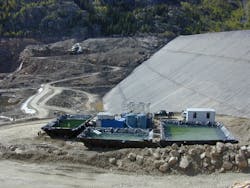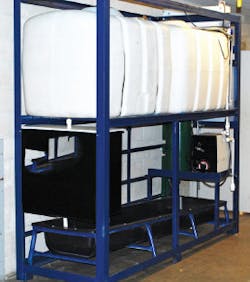Unlike energy resources, there are no alternative choices for water. This natural resource is an integral part of life, and all industrial production. Standard processes such as fabrication, dilution and cooling all require water. As such, global water demand and contamination concerns have industry leaders focused on innovative technology to treat and reuse industrial wastewater.
According to the OECD Environmental Outlook to 2050 (www.oecd.org), global water demand is projected to increase by 55 percent between 2000 and 2050, by which time more than 40 percent of the global population may be under severe water stress. In addition, the UN World Water Report (www.unwater.org) states some 300-500 million tons of heavy metals, solvents, toxic sludge, and other wastes accumulate each year from industry, most of which gets into the freshwater supply. In some developing countries, 70 percent of industrial wastes are dumped into untreated waters where they pollute drinking water.
Water Usage & Environmental Impact
Increasing demand for water and tightening environmental standards are driving the need for innovative solutions to help recycle industrial wastewater. Industries that have high water volume requirements, such as oil/natural gas recovery and pulp and paper, are leading the way to implement advanced technologies to treat and reuse wastewater to help minimize the overall environmental impact.
Current methods of wastewater treatment in many industries, including natural gas recovery and pulp and paper, have a high environmental impact. Many require increased truck traffic, with concerns about polluted emissions and soil/groundwater contamination. Moreover, current industrial wastewater treatment methods require large portions of land for the placement of the settling pools and do not solve sludge disposal concerns or odor complaints due to bacteria and decay from the settling pools.
Many industries are turning to technology to modernize the use of water in manufacturing processes to increase sustainability efforts and obtain nearly 100 percent recycled water.
New Demand for Proven Technology
Electrocoagulation is a technology that removes contaminants from aqueous streams with 99.9 percent effectiveness. It can be used effectively on both influent and effluent streams to allow the use or discharge of an industrial waste stream. The process uses electricity, rather than expensive, dangerous and sometimes toxic chemicals to remove contaminants. Electrocoagulation can also be a pretreatment for other processes, such as Reverse Osmosis, or a polish treatment for traditional treatment processes.
Portable electrocoagulation system is employed at a remote field operation to remove macadam from a community reservoir.
The electrical current is introduced into the water via parallel electrodes constructed of various metals generally selected to optimize the removal process. The two most common electrode materials are Iron (Fe) and Aluminum (Al). In accordance with Faraday’s Law, metal ions will be split off or sacrificed into the liquid medium. This will form a nucleus, which will attract the contaminants into a precipitate that will be removed from the treated fluid. These metal ions tend to form metal oxide or hydroxide nuclei that are an electrocoagulation attractant to the contaminants, which have been destabilized. The quantity of electrical current required varies with the liquid that is to be treated.
The mobility of this technology has created applications for custom mobile treatment units for onsite water reuse for production, but to also increase capacity of existing water treatment facilities. The EC units process as much water volume as is necessary to meet site-specific criteria. The range of water treated varies from 100 gallons per minute, up to 15 million gallons per day. Each unit has the capacity to process approximately 50,000 (GPM) per module, with an average use of 10–15 modules, depending upon water volume and available space.
Municipal & International
Municipalities are exploring technology that provides onsite wastewater treatment systems to protect surface and ground water quality. A major positive aspect of EC technology is the resulting water can be used immediately, and in most locations no additional treatment is necessary. The EC system can remove metals and other naturally occurring elements of concern without the use of chemicals or additives.
In fact, the U.S. Environmental Protection Agency (EPA, www.epa.gov) has launched a model program in the Chesapeake Bay watershed to help states reduce excessive nutrients from entering the Bay from onsite or septic systems. States from New York to California are challenged by ways to keep water from lakes and streams clean from contaminated runoff.
On an international basis, governments are looking to technology to help eliminate chemical processes and recycle water. In addition, the recent oil spill in Thailand, a lack of sanitation systems in India, and the wide spread toxic water issues in China due to the rapid rise of industrialization have the attention of the entire world.
EC system cleans asphalt from a Colorado reservoir.
Pulp & Paper Mill Application
As one of the largest industries in the United States, the pulp and paper mill industry has a significant environmental footprint with manufacturing facilities located in 42 states at more than 500 locations, according to the EPA.
Processing requires one of the highest water volumes in the industrial water industry. Current processing methods commonly use 750 million gallons of water per month. In addition, companies often need to purchase city water or use lakes and streams as water sources. Much of the water is lost due to evaporation during the production process, further increasing the need for fresh water resources.
In a recent study titled, CEO 360 Degree Perspective on the Global Pulp and Paper Water and Wastewater Treatment Market, Frost & Sullivan (www.frost.com) attributes growth in wastewater treatment to the high cost of water and a need for more efficient water reuse systems. According to the study, the global pulp and paper water treatment market earned revenues of more than $983.9 million in 2012 and estimates this to reach $1.57 billion in 2020.
This high water demand is driving the adoption of technology that helps to conserve water and reduce chemical emissions.
Traditional pulp and paper processing methods include various forms of bleaching that can produce waste streams containing chlorine compounds and organics. This mixture of chemicals may result in the formation of a number of toxic chemicals such as dioxins, furans and chlorinated organics—all of which are not reduced by water treatment plants.
With traditional treatment processes, multiple settling ponds are used to separate the solid material from the wastewater. As the solids separate, the water runs off the top. The water moves from pond to pond via piping or other structures. The excess solids create disposal issues. One paper mill may dewater an average of 50 percent solids, which could result in as much as 15–20 cubic yards of material produced a day.
Modern Industrial Wastewater Treatment
With the use of modern technology, such as our closed-loop system using electrocoagulation in the pulp and paper industry, nearly 100 percent water reuse can be produced with the virtual elimination of settling ponds. As a result, paper production is likely to increase with faster access to treated water for reuse.
Moreover, any odor problems from bacteria in the stagnant water of the pools would be eliminated with sludge significantly reduced. Any sludge that is produced would be rendered inert and can then be recycled as fertilizer and sold to agriculture or composting facilities, for example.
Test results from water produced at three pulp and paper manufacturing locations within the United States and Canada, further show the effectiveness of this technology. Using a non-optimized electrocoagulation technology unit for testing purposes only, the suspended solids were reduced by more than 98 percent, while metals and other constituents ranged in the more than 90 percent reduction. With site-specific optimization, results for water treatment increase to more than 99 percent. In addition, dioxins were reduced by 100 percent.
Compact EC system treating groundwater contamination at the Colorado Convention Center to meet discharge requirements.
The Future of Wastewater Treatment Is Now
We believe the future of industrial wastewater treatment will be mobile, integrated into corporate sustainable initiatives, and include renewable strategies. Onsite treatment and reuse will help increase treatment capacity to keep pace with increasing populations, production needs, and demand for drinking water, while reducing overall water consumption and environmental impact.
In addition, the effort by corporations to set water reduction goals within sustainable development initiatives will continue to increase, as well. Currently, companies such as PepsiCo use as much as 100 billion liters of water per year to make its drinks and potato snacks. According to a BBC report, last year PepsiCo reduced its water consumption by 14 billion liters, saving $15 million and meeting its 20 percent water reduction goal four years early.
The need to reduce water consumption for industrial production is an issue of global importance. The incorporation of renewable energy sources, such as solar into the treatment process will continue to increase. In the near future, it may be commonplace for solar energy to power mobile well water units.
Water demand for industrial processes may not decrease, but the ability to recycle and reduce freshwater use in plants and mills will positively impact sustainability efforts.
Patricia Els is Chief Science Officer for Advanced Waste & Water Technology, Inc., a New York-based firm specializing in the removal of chemical and liquid waste, water and waste treatment options and disposal services. Her expertise includes the development of wastewater treatment solutions that meet DEC regulations and permit discharge requirements for a variety of industries. Additionally, she is an invited participant at EPA wastewater treatment workshops to share her technical expertise on wastewater treatment technologies.
Ms. Els can be reached at [email protected] or 917 324-0166.





